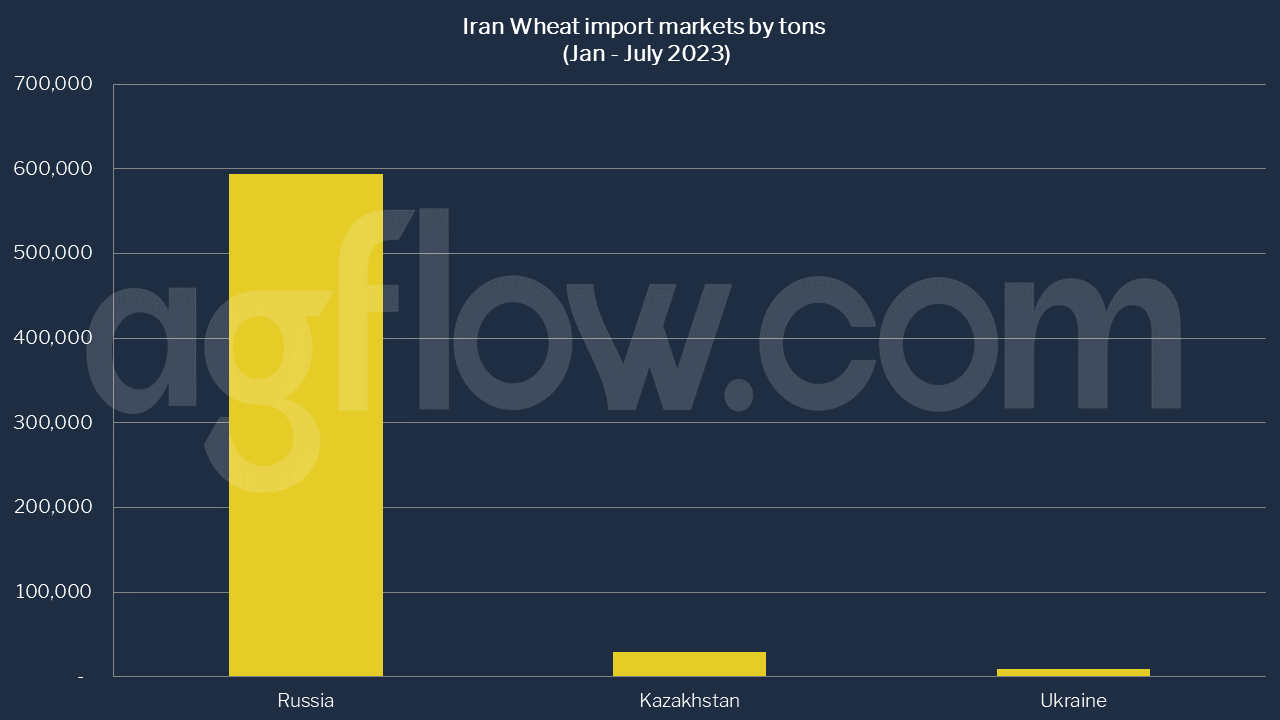Iran Wheat Import: Kazakhstan Ships From Its Aktau Port
Talk to our team about AgFlow's offering →
Reading time: 2 minutes
Wheat, the golden grain that has been a staple in our diets for millennia, is more than just food. It’s a symbol of life, growth, and prosperity. But what happens when this vital commodity becomes a complex puzzle in the world of international trade? Let’s take a journey into the heart of Iran’s wheat industry, exploring the dynamics of trade, export, and import from January to July 2023.
Iran: A Land of Contrasts
Iran, a country rich in history and culture, is also a land of contrasts. With vast deserts and fertile plains, Iran’s agricultural landscape is as diverse as its people. But how does this nation, known for its oil reserves, fit into the global wheat market?
Wheat in Iran: A Growing Demand
Wheat is more than just a crop in Iran; it’s a necessity. As the population grows, so does the demand for this essential grain. But can Iran’s domestic production keep up? The answer is a complex interplay of factors.
1. Domestic Production: A Balancing Act
Thanks to technological advancements and government support, Iran’s domestic wheat production has grown significantly. But is it enough? The challenge lies in balancing the need for self-sufficiency with the realities of climate, water scarcity, and land limitations.
2. Imports: A Necessary Evil?
While striving for self-sufficiency, Iran still relies on imports to meet its wheat demand. But why import when you can produce? The answer lies in the quality, availability, and ever-fluctuating global market prices. Importing high-quality wheat for specific needs is a strategic move, but it’s not without its tradeoffs.
3. Exports: A Double-Edged Sword
Exporting wheat may seem counterintuitive for a country striving to meet domestic demand. However, the export of specific wheat varieties can be lucrative. But what’s the cost? The balance between earning foreign currency and ensuring food security is delicate.
According to AgFlow data, Iran imported 0.6 million tons of Wheat from Russia in Jan – July 2023, followed by Kazakhstan (29,500 tons) and Ukraine (8,500 tons). Total imports hit 0.6 million tons in Jan-July 2023. Iran was purchasing large amounts of Wheat from Russia, such as 100,000 tons and 76,000 tons. Russia’s main shipping port to Kazakhstan is Astrakhan. Kazakhstan exports also 3,500 – 6,500 tons of Wheat to Iran.
May shipments were the largest in Jan – July of 2023, with 0.31 million tons. The following months were July (0.15 million tons), Apr (0.13 million tons), and Mar (29,250 tons).

Challenges and Opportunities: A Global Perspective
The global wheat market is like a giant chessboard, and Iran is a key player. But what are the challenges and opportunities in this intricate game?
1. Sanctions and Political Climate: The geopolitical landscape can be a minefield. Sanctions and political tensions can hinder trade, affecting both imports and exports. How does Iran navigate these turbulent waters?
2. Climate Change and Environmental Factors: Climate change is not just a buzzword; it’s a reality. Droughts, floods, and unpredictable weather patterns can wreak havoc on wheat production. How does Iran adapt and innovate?
3. Economic Factors: Currency fluctuations, inflation, and global market trends can turn the tables overnight. How does Iran stay ahead of the game?
Conclusion: A Future of Possibilities
Iran’s wheat trade is a complex tapestry woven with opportunity, challenge, and innovation threads. The journey from January to July 2023 has been a testament to Iran’s resilience and strategic thinking.
The story of Iran and wheat is not just about numbers and trade agreements; it’s about people, culture, and a nation’s quest for growth and stability. It’s a narrative that resonates with professionals in the agricultural commodity industry and anyone interested in the global dynamics of food and trade.
In the end, the question isn’t just about how much wheat Iran can produce, import, or export. It’s about how a nation balances its needs, aspirations, and responsibilities in a world that’s ever-changing.
Try AgFlow Free
Access Free On Updates for Corn, Wheat, Soybean,
Barley, and Sunflower Oil.
No Credit Card Required & Unlimited Access In Time

